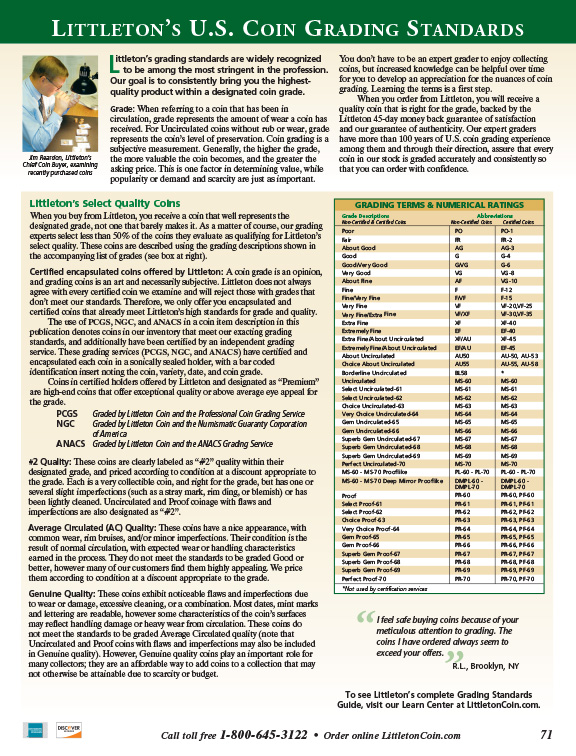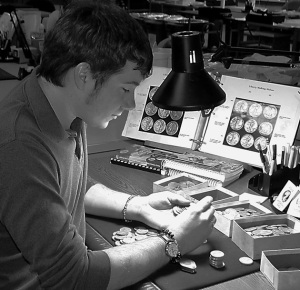You need more than a Magnifier for Grading!
Why Experience Counts…
So you have your coin, you’ve admired it and now it’s in your collection, but did you ever wonder what it takes to be able to grade one? Each year our expert staff examines millions of coins and about 50% of those meet Littleton’s standards for quality. On average, a Littleton grader looks at over 600,000 coins annually. It takes one of our graders about 5 years to master many aspects of grading.
Grading is a subjective measurement and an art. Like baking the perfect dish, taking the perfect photo or shooting a birdie in golf, coin grading takes both skill and practice. But, did you know even a coin that is properly graded could be unattractive? Each coin has a unique appearance and that plays into grading.
One of our core values is to select only pieces with eye appeal. What are coins with eye appeal? They’re the ones that are pleasing to look at for the grade.
With these questions in mind and hoping to learn more, I spoke to Roger “Butch” Caswell, one of our long-time senior buyers and trainer for our grading staff, to learn what goes into being a Littleton grader, what they look for in a coin for it to be good enough to be a “Littleton.”
Where do you start when you begin as a Littleton grader?
“When people start working in the coin buying department as a grader, they begin by picking out, or culling the obvious rejects. This helps them get used to looking at and handling coins. They do this for a few months.”

Click to download or print Littleton’s Grading Guide and start learning about terminology & factors that affect a coin’s grade.
How do they learn to grade?
“From culling, they begin to learn about Littleton’s grading standards. A new grader works one-on-one with a mentor at first, and then in teams. They learn all about various coin types – Indian Head cents and Lincoln “Wheatie” cents, Liberty Head “V” nickels and Buffalo nickels, etc.
Every day they alternate types so they become familiar with various aspects of each series. In the morning, they may work on Indian cents and in the afternoon on Franklin or Liberty Walking half dollars. Before they switch to another coin type, they review the series they are switching to by looking at grading books and actual coin samples. Using actual coin samples, they review both problem-free samples and problem samples (with cleaning, damage, corrosion etc.). They receive constant feedback on how they’re doing and progressing. Through this process, they reach technical proficiency and are qualified as a grader. But it doesn’t stop there, we’re always maintaining our skills.”
How do you maintain grading skills?
One of the ways we maintain skills is by doing peer-to-peer review. This helps everyone stay sharp. Because we work in teams, a team member crosschecks your work. The same person never checks your work all the time because we alternate on a weekly basis. Plus, the senior buyers also review the graders’ work.”
How do they learn to look for eye appeal?
“Well, Littleton uses the higher end industry guidelines to grade by, like ANA and Photograde. In addition, we’ve developed our own full color photo-guide for in-house use. It shows actual coins in grades ranging from Good to About Uncirculated. Plus, we have actual coin samples and sets graders review as they switch various coin types. In addition, we use the same lighting at every station so you always look at the coins under the same type of light. We do this so everyone stays consistent to Littleton standards and we can deliver a quality product for the grade to the customer.”
Clearly there is a lot that goes into being a grader, what do you think? Could you be one?
This is the first in a series of articles about grading – check back soon for more.





Excellent article.
Thanks Bill. We’re glad you enjoyed it!
I’m new to coin collecting and I’m having trouble understanding the point system when examining older coins versus new coins. Are older coins immediately low in grade because of appearance or is there a respect for the aged coins.
Hi Greg, We recommend visiting the Learn section of our website. We offer grading guides for coins, paper money and ancient coins, as well as glossaries, how to collect booklets and more. This section contains helpful information for both the beginning and experienced numismatist. Below is a link, for your convenience. http://bit.ly/1vdzJvn
What does reprocessed mean, when grading a coin
Hi Ira, I’m assuming you’re referring to 1943 Reprocessed Steel Cents. If so, it refers to the process of stripping the zinc from the coins, de-rusting the surface, and then recoating the coins in zinc. I hope that helps. Have a great weekend! -Rick
What does “genuine” mean for grading?
Hi Gregory, thanks for stopping by! In some cases, a coin can exhibit noticeable flaws and imperfections due to wear, damage or cleaning or a combination of the three. Unfortunately they don’t meet the standards to be graded Average Circulated. They are still authentic examples, so we simply refer to them as Genuine. Genuine examples play an important roll to many collectors as they allow an affordable way to add coins to a collection that may not be otherwise attainable due to scarcity or budget. Happy new year!